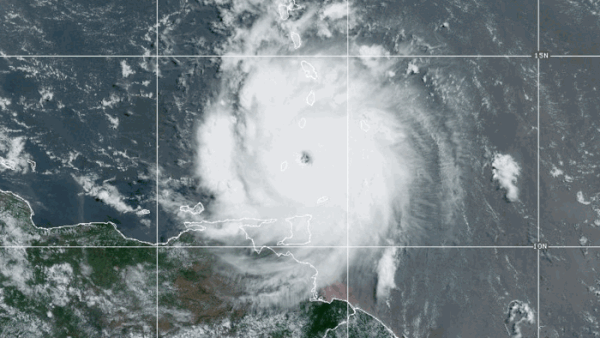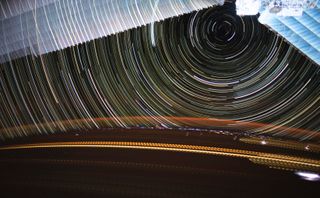Space pictures! See our space image of the day
Your home as far away from home as possible
Astroscale's space junk triumph

Wednesday, July 31, 2024: Astroscale's ADRAS-J satellite captured these stunning views of defunct Japanese rocket stage tumbling in orbit as part of its space debris rendezvous test flight. The images, released July 30, show a 15-year-old rocket stage (that would weigh 3 tons on Earth) as seen by the Active Debris Removal by Astroscale-Japan spacecraft on July 15 and 16. The satellite was able to approach within 164 feet (50 meters) of the 36-foot (11 m) rocket body in a tech demonstration for space junk cleanup efforts. -- Tariq Malik
Read more: Space-junk scout captures amazing fly-around footage of discarded rocket in orbit (video)
Atlas V launches its last Space Force mission

Tuesday, July 30, 2024: United Launch Alliance's (ULA) venerable Atlas V rocket flew its final national security mission this morning. The Atlas V launched from Florida's Canaveral Space Force Station on Tuesday at 6:45 a.m. EDT (1045 GMT), on a classified mission for the U.S. Space Force called USSF-51. USSF-51 is a landmark mission: It was the last national security space launch (NSSL) for a member of the Atlas rocket family, which has been flying since 1957. — Mike Wall
Read more: Atlas V rocket launches its final national security mission for US military (video)
Zodiacal light at the VLT

Monday, July 29, 2024: Just after sunset in the Chilean Atacama Desert, at ESO's Paranal Observatory, the Very Large Telescope (VLT) stands tall against the sky as the stars begin to emerge. This image is ESO's image of the week, and features the lights of Mars and Venus, shining withing the blue-hued zodiacal light.
The zodiacal light is a phenomenon that can occur just after sunset or before sunrise, where tiny particles of dust in the atmosphere scatter the sunlight to create the band of hazy blue light glowing in the sky.
Paris as the games begin!

Friday, July 26, 2024: As the 2024 Summer Olympics begin in France, the host city is getting the satellite view treatment. Pictured from high above the Earth, Paris is seen the day of the games' opening ceremony. From the website of the European Space Agency (ESA), "This image was acquired by the Pléiades Neo mission. This constellation is part of ESA’s Third Party Missions programme."
Get the Space.com Newsletter
Breaking space news, the latest updates on rocket launches, skywatching events and more!
Full moon for the Olympics

Wednesday, July 24, 2024: July's full moon captivated skywatchers worldwide as it shone brightly over the weekend. With the Paris 2024 Olympic and Paralympic games only days away, the golden full moon took the number 1 position in the skies above Paris on July 21, 2024. This stunning image of the full moon shining next to the Eiffel Tower adorned with Olympic rings was captured by photographer Wang Zhao.
Juno sees Jupiter's good side

Tuesday, July 23, 2024: NASA's Juno spacecraft launched in 2011 and spent five years journeying to our solar system's largest planet. Ever since, the probe has sent back the most wonderous images of Jupiter, and its latest does not dissapoint. Juno completed its 61st flyby of Jupiter in May, and captured this incredible display of atmospheric storms and gases from about 18,000 miles (29,000 kilometers) above the tops of Jupiter's clouds. From NASA, "It provides a detailed view of chaotic clouds and cyclonic storms in an area known to scientists as a folded filamentary region. In these regions, the zonal jets that create the familiar banded patterns in Jupiter’s clouds break down, leading to turbulent patterns and cloud structures that rapidly evolve over the course of only a few days."
25 images for 25 years of Chandra and Space.com!

Monday, July 22, 2024: The Chandra X-ray Observatory is celebrating 25 years in space! Coincidentally, Space.com celebrated its 25th anniversary last week, too. In honor of the space telescope's big milestone, NASA has released a collection of new images from Chandra that are meant to highlight the range of its capabilities. The images include x-ray views of Jupiter, black holes, nebulas and exploded stars, and are truly wonderous.
SpaceX's Mighty Starship Super Heavy

Tuesday, July 16, 2024: SpaceX's mighty Starship Super Heavy booster, which boasts 33 Raptor engines (28 more than NASA's Saturn V moon rocket first stage) roars to life during a static fire test at the company's Starbase test site near Boca Chica Beach in South Texas on July 15. Unlike the Saturn V rocket, which launched NASA's Apollo 11 astronauts to the moon 55 years ago today, the Starship Super Heavy booster is designed to be fully resuable, flying back to its launch site to be captured by two "Chopsticks" of its "Mechzilla" launch tower.
Read more: SpaceX test-fires Super Heavy Starship booster ahead of 5th flight (video)
Ariane 6 has entered the game.

Monday, July 15, 2024: Europe's new Ariane 6 rocket has finally taken flight, carrying the hopes of a continent on its broad back. The Ariane 6 launched for the first time ever July 9, lifting off from Europe's Spaceport in Kourou, French Guiana, at 3:01 p.m. EDT (1901 GMT). There was a lot riding on this debut: It came a year after the retirement of Ariane 6's predecessor, the workhorse Ariane 5, left Europe unable to launch big satellites on homegrown rockets.
Ariane 6 successfully deployed nine cubesats to orbit about 65 minutes after liftoff, as planned, including the European Space Agency's (ESA's) Young Professionals Satellite, YPSat. Following fairing separation, YPSat captured this image of the sun and Earth, as the Ariane 6 earned its place among today's operational launch vehicles.
Read more: Europe's new Ariane 6 rocket launches on long-awaited debut mission (video)
Dragons sleep among the stars

Friday, July 12, 2024: SpaceX's Crew Dragon Endeavour is seen docked to the forward port of the International Space Station's Harmony module. In the background, the arm of the Milky Way reaches from below, filling the black abyss with stars.
Endeavour carried NASA astronauts Matthew Dominick, Michael Barratt, Jeannette Epps and Russian cosmonaut Alexander Grebenkin to the orbiting lab for a six-month stay as a part of SpaceX's Crew-8 mission for NASA. Crew-8 launched atop a SpaceX Falcon 9 rocket from NASA's Kennedy Space Center in Florida on March 3, and docked March 5th. The crew is scheduled to return sometime mid-August, following the arrival of the Crew-9 astronaut rotation.
Sprites from space!

Thursday, July 11, 2024: NASA astronaut Matthew Dominick snapped this photo of the rare red sprite phenomenon from the International Space Station earlier in the year, and the results are stunning. "Super lucky a few weeks ago when shooting a time-lapse of a lightning storm off the coast of South Africa. One of the frames in the time-lapse had a red sprite," Dominick wrote on X after reviewing his photos last month.
Red sprites, also known as red lightning, occur during some extremely intense thunderstorms. Most lightning flashes move down from the clouds to the ground, a sprite goes in the opposite direction: up, into the upper atmosphere. These sprites are very brief, lasting only for about a millisecond, which makes them difficult to observe even with professional equipment from orbit. That said, they can be very large, sometimes spanning as large as 30 miles (48 km) across. — Elizabeth Howell
Read more: Astronaut photographs rare red lightning phenomenon from ISS
Gateway habitat assembly underway

Wednesday, July 10, 2024: Lest anyone be surprised in a few years when the first completed module of the lunar Gateway for NASA's Artemis program launches, Thales Alenia Space has shared another progress photograph of the HALO (Habitation and Logistics Outpost) module's base assembly component as it undergoes testing at the company's facility in Turin, Italy. NASA has contracted Northrop Grumman to construct HALO, which is one of four modules where Artemis astronauts will live, work and ferry to and from the moon's surface.
Firefly lights up the sky

Tuesday, July 9, 2024: Late in the evening, just after sunset last week, Firefly Aerospace's Alpha rocket launched from California's Vandenberg Space Force Base on the "Noise of Summer" mission, carrying eight cubesats to orbit as a part of NASA's Cubesat Launch Initiative, which aims to help pave a path to space for satellites developed at U.S. colleges, universities and nonprofit organizations. The cubesats were developed by teams at the University of Arizona, the University of Kansas, the University of Maine, the University of Washington, a nonprofit called Teachers in Space, and two NASA facilities — Johnson Space Center in Houston and Ames Research Center in Silicon Valley.
Read more: Firefly Aerospace launches 8 cubesats to orbit on 5th-ever launch (video)
Russian modules above Earth

Monday, July 8, 2024: Today's space image of the day is this long duration photograph taken aboard the International Space Station. Orbiting the Earth above the Pacific Ocean, this image shows Russian segments of the space station, including the Rassvet module on the left, with the Soyuz MS-25 spacecraft docked with the Prichal segment attached to the Nauka science module on the right.
Copernicus captures a crater

Tuesday, July 2, 2024: Imaging satellites from the European Space Agency (ESA) captured this picture of Barringer Crater, in Arizona. The Copernicus Sentinel-2 spacecraft are a pair of twin satellites that circle the Earth in a polar orbit. The duo orbits at an altitude of about 490 miles (786 kilometers), and captured the data used to process this image while flying over the southwest United States.
Barringer Crater is nested in the Arizona desert with a depth of 570 feet (174 meters) and 4,100 feet (1.25 kilometers) across. The impact is estimated to have occurred between 49,000 and 50,000 years ago, and is believed to have been caused by an iron-nickel meteorite, about 130 feet (40 meters) wide.
Beryl barreling through!

Monday, July 1, 2024: Satellites are monitoring Hurricane Beryl as it dumps destructive rain and winds on the Caribbean island of Carriacou in Grenada, where it made landfall on Monday (July 1) morning as "an extremely dangerous" Category 4 storm.
NOAA's GOES-East satellite captured nearly real-time views of Beryl multiple times over the weekend as it closely tracked the powerful storm's progress in the Atlantic ocean. The footage, taken from the satellite's position about 22,236 miles (35,785 kilometers) above Earth's equator, shows the storm battering a group of islands in the Atlantic's Caribbean Sea known as the Windward Islands, which include Grenada, St. Vincent, Martinique and a cluster of small islands called the Grenadines. — Sharmila Kuthunur
Archives
Check out our Image of the Day Archives for more awesome photos.
Image of the Day 2020 Archive

Image of the Day 2019 Archive

Can't find the date you're looking for? It may have been a weekend or holiday, when we don't normally update our Image of the Day.
Click 'NEXT PAGE' below for June >
June >
Join our Space Forums to keep talking space on the latest missions, night sky and more! And if you have a news tip, correction or comment, let us know at: community@space.com.

Space.com is the premier source of space exploration, innovation and astronomy news, chronicling (and celebrating) humanity's ongoing expansion across the final frontier. Originally founded in 1999, Space.com is, and always has been, the passion of writers and editors who are space fans and also trained journalists. Our current news team consists of Editor-in-Chief Tariq Malik; Editor Hanneke Weitering, Senior Space Writer Mike Wall; Senior Writer Meghan Bartels; Senior Writer Chelsea Gohd, Senior Writer Tereza Pultarova and Staff Writer Alexander Cox, focusing on e-commerce. Senior Producer Steve Spaleta oversees our space videos, with Diana Whitcroft as our Social Media Editor.
-
rod ReplyThe Exoplanets Channel said:The images are truly breath-taking.
The Exoplanets Channel, what star and reddish exoplanet is shown in your picture, looks like about 8" angular separation? I use this site as my canonical reference to exoplanets, The Extrasolar Planets Encyclopaedia Currently 4150 exoplanets are listed. -
swiggly ReplyThe Exoplanets Channel said:The images are truly breath-taking.
My Comet Image:
Neowise -
rod Reply
This is a very good image here. In enjoyed some recent views of NEOWISE using my 90-mm telescope at 40x early, shortly after 0415 EDT. Bifurcated tail obvious too.swiggly said:My Comet Image:
Neowise -
Helio The IOD image for yesterday of the Veil nebula is stunning! The graphics are such that it's almost as if it has an oil film on top. It has both 3D and texture feel to it.Reply -
Astro.Letizia I hope they start posting these daily again! I always start my day off with the newest image but it's been a couple of months now :(Reply